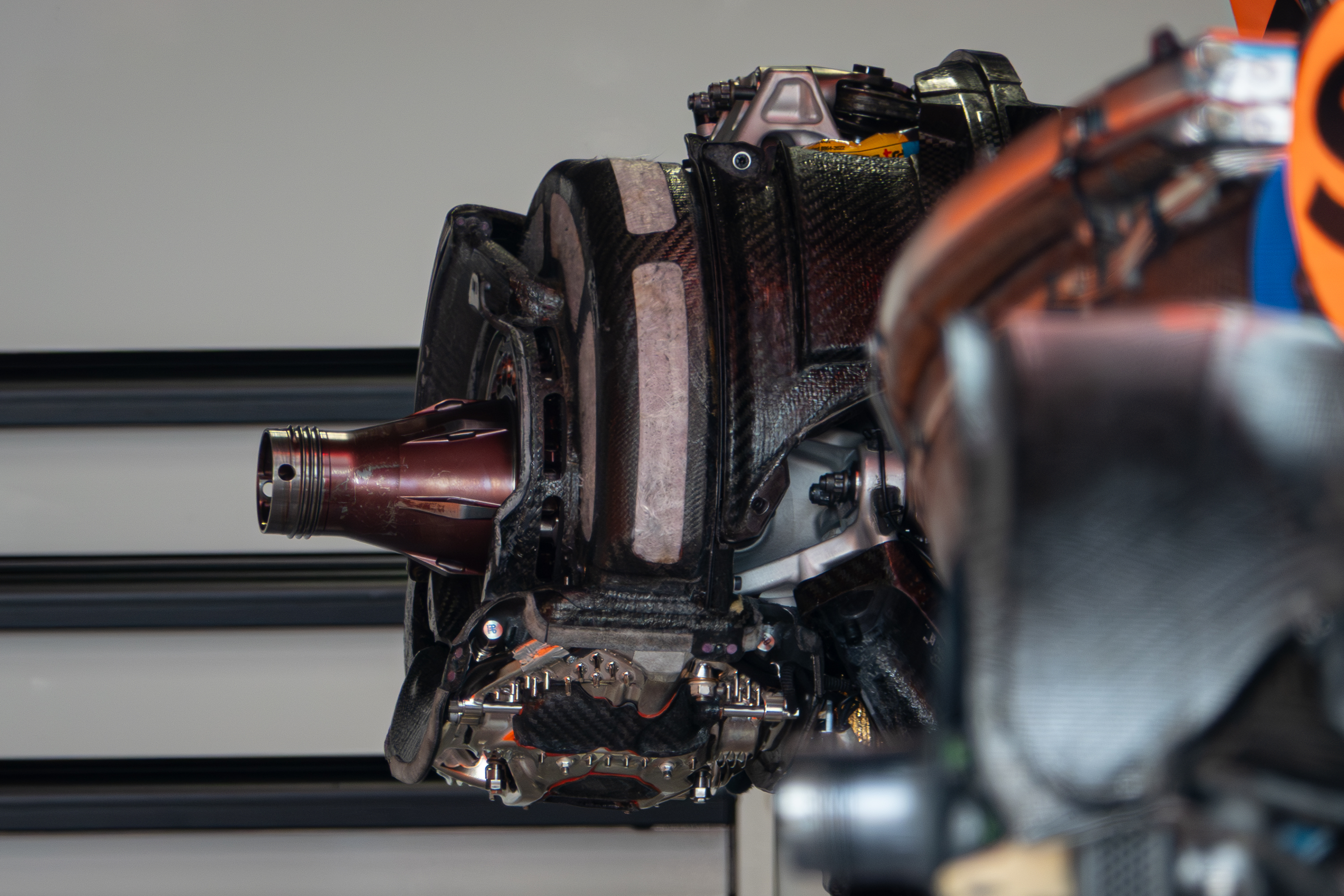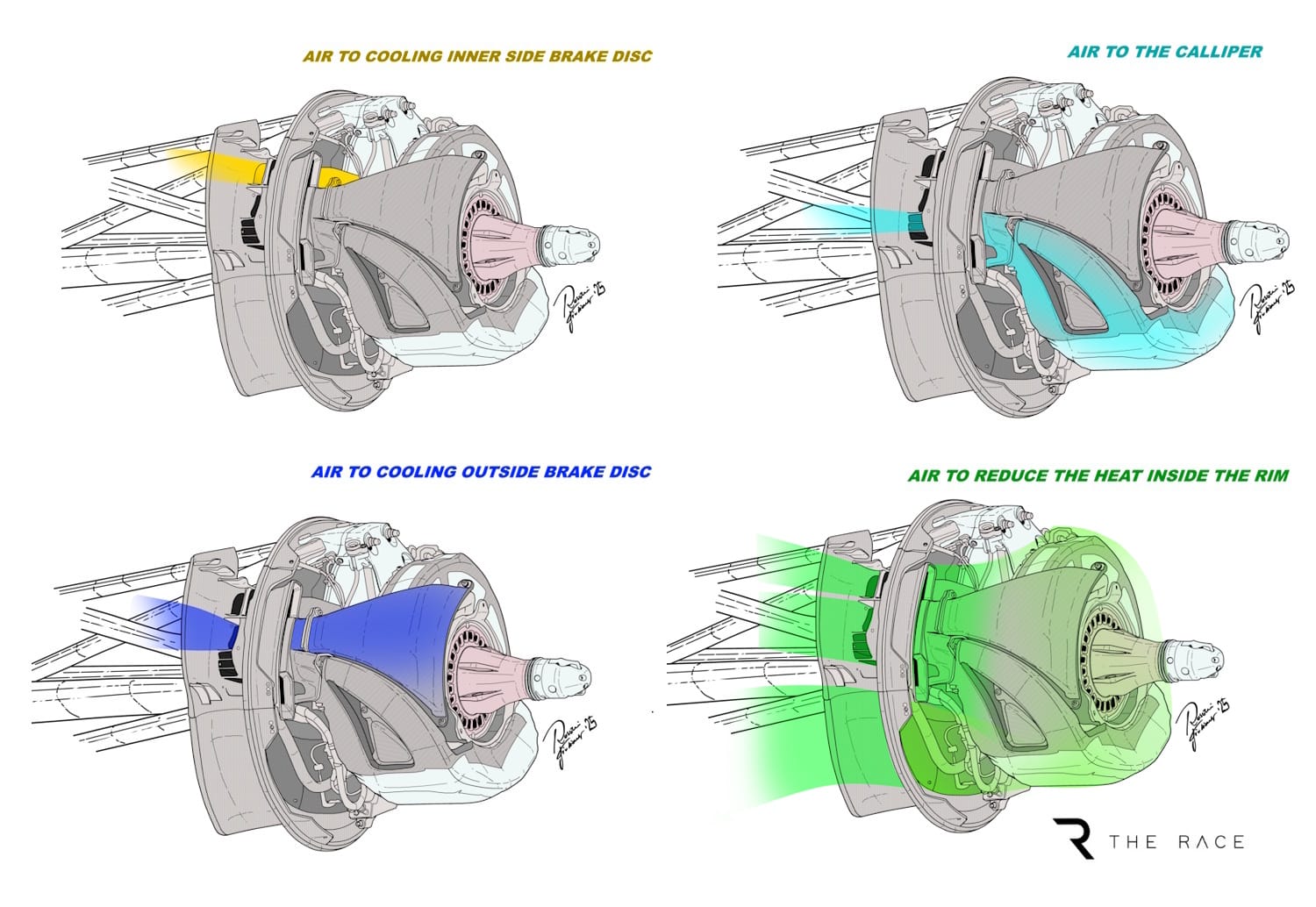
Isolation of the brake disc heat seems important.

It is also interesting that Red Bull complained at the Austrian GP last year that McLaren had driven with temperature sensors on the brake drums. This is only allowed in free practice. According to Red Bull, McLaren should have done it at least once during the rest of the weekend. If this is true, then it could be interpreted to mean that the engineers wanted to find out more about the temperatures inside the fairing during a race.
It is also noticeable that McLaren often drives aggressive long runs in the third free practice session and the competition is worlds behind. It may be possible to find out under extreme conditions whether everything works as desired.
It's obviously not a piece of cake to make this process work. There is a lot of development and testing work involved. It looks like McLaren has already tried a precursor to the system after the 2024 summer break. From the GP Holland onwards, Lando Norris and Oscar Piastri excelled, especially in the second half of the races. The competition was already wondering how the two kept their tires in such good shape.
Even if the opponents already know exactly what McLaren is doing, it is not so easy to copy the trick. Red Bull may already have a theory that aims in this direction. Recently, Max Verstappen has complained more and more often about mysterious brake problems. When asked whether this was related to the tyre cooling, team boss Christian Horner gave only monosyllabic answers.
The miraculous heat storage system
Inside the drum-shaped brake covers, there is usually a second sleeve on which fins are attached, which influence the flow of the air. A channel runs between the two walls, in which the temperature of the outer shell radiates onto the rim is decided. This is the case with all cars.
One could now imagine that McLaren shields this channel towards the inner fairing with a very special material. A so-called phase change material, which is also used as a heat storage device in batteries, for example. The same requirements apply there as for the tires. The temperature should rise quickly, but not overshoot a specific target.
In the case of the tires, it would work like this: The dissipating brake heat heats up the tire. According to this theory, McLaren would stop this process by having the insulating material change its physical state. For example, from solid to liquid. In this transition, the temperature remains the same despite further heat supply from the outside.
The temperature in the outer drum is the trigger for the phase change. The material used depends on the temperature at which the stop sign must be placed. The amount of phase change material used determines how long the heat is kept stable at the desired level. A clever air duct system allows the cooling direction to be reversed. Then the brakes are cooled to a point where the material has solidified again.
There is not much room to store anything under the brake tins. I think that if there is usage of a phase changing material, then we might be looking at its construction. Where would you put the material? Around the brake disc. That is the most efficient way to absorb heat from the brake disc.






You've touched on this a little. But if there is a phase change material that is isolating the brakes heat would this in turn mean you need more cooling potentially on the inside of where ever you have the PCM? As I understand it as a well arm chair expert is that would trap more heat that could naturally radiate through the rest of the rest of the system, into the wheels and so on, if I am right could this be the cause of the extra drag the McLarens seem to have you've mentioned?AR3-GP wrote: ↑11 May 2025, 17:20https://i.postimg.cc/L6FtZ1HF/image.png
Isolation of the brake disc heat seems important.
I'm not sure so anymore.Watto wrote: ↑12 May 2025, 02:36You've touched on this a little. But if there is a phase change material that is isolating the brakes heat would this in turn mean you need more cooling potentially on the inside of where ever you have the PCM? As I understand it as a well arm chair expert is that would trap more heat that could naturally radiate through the rest of the rest of the system, into the wheels and so on, if I am right could this be the cause of the extra drag the McLarens seem to have you've mentioned?AR3-GP wrote: ↑11 May 2025, 17:20https://i.postimg.cc/L6FtZ1HF/image.png
Isolation of the brake disc heat seems important.
Maybe I’m wrong but that looks just like compacted fiberglass wool to me which is an insulator. So if they shield the disk with that, they need a different way to cool and not glaze the carbon disk.AR3-GP wrote:A high resolution picture of Mclaren's brake disc shield. The white stuff, what is it? It has the appearance of a fabric.

You just said the same as I did, but with extra steps.Andi76 wrote: ↑09 May 2025, 21:42Actually Newey did not even invent the Red Bulls Blown-Diffuser. It was basically a copy of Ferraris intended diffuser for 1998. Unfortunately Carbon and heat-protecting was not at the level at that time to make it work, so Rory Byrne came up with the Periscope-Exhaust, but the famous first Blown-Diffuser Newey used at Red Bull was actually an almost 1-1 copy of this system.krisfx wrote: ↑09 May 2025, 20:02He really does!Hoffman900 wrote: ↑08 May 2025, 15:13
I have a running joke with friends that Newey gets credit for inventing everything

5.25.2 Cooling systems: The cooling systems of the power unit, including that of the air destined for
combustion, must not intentionally make use of the latent heat of vaporisation of any fluid
with the exception of fuel for the normal purpose of combustion in the engine as described in
Article 5.11.3.
14.6.1 The driver cooling system is defined as a system, the sole purpose which, is to provide
additional cooling for the driver.
The driver cooling system may make use of the latent heat of vaporisation, or of sublimation,
of a substance.
As for the cake tins, note the outboard edge (by the spindle) must be sealed/gasketed per the regs, while the inboard edge (by the inboard wheel lip) can be sealed to the wheel or not, it's up to the team. The gap between the cake tin and the wheel barrel looks about 5 mm wide, maybe even narrower. A very thin layer of air then sits between these two parts. Recall Merc used to run knurled/ribbed wheel barrels in exactly that same area a few years ago. It looks like a polymer gasket is used, across teams, on the cake tin photos I've seen, to bridge the wheel to the tin. Either way, the choice will determine whether or not the thin sleeve of air between the cake tin & the wheel is a sealed envelope or not. Maybe they want it to be sealed so that it's acting as a more stable thermal pathway between the two parts. The "cake tin"/drum itself is such a thin, lightweight part that it's hard to image it having much influence as a thermal mass (using phase change material or not) upon the greater mass of the magnesium wheel.11.5 Liquid cooling
Liquid cooling of the brakes is forbidden.
3.14.2 Drum
The Front Drum and Rear Drum bodywork:
a. must be made to the geometry defined by RV−FWH−DRUM and RV−RWH−DRUM
respectively.
b. must be fitted with an Aerodynamic Seal, in the outboard of the two annotated
volumes, between the drum and the axle.
c. may be fitted with an Aerodynamic Seal, in the inboard of the two annoted volumes,
between the drum and the wheel rim.
d. both Aerodynamic Seals must be circumferential, continuous (around an arc of 360°)
and uniform.
from the twitter linkAlso, this would be speed depending, as the rate of heat convection would depend on the mass flow of air through the system. Thus, less heat convected away at lower speeds, and more at higher speeds. So it's possible that the drivers can help control tyre heating and cooling during their prep laps.
Interesting - but on this did Stella say something along the lines of their solution was independent of the driver?AR3-GP wrote: ↑12 May 2025, 17:52from the twitter linkAlso, this would be speed depending, as the rate of heat convection would depend on the mass flow of air through the system. Thus, less heat convected away at lower speeds, and more at higher speeds. So it's possible that the drivers can help control tyre heating and cooling during their prep laps.